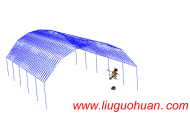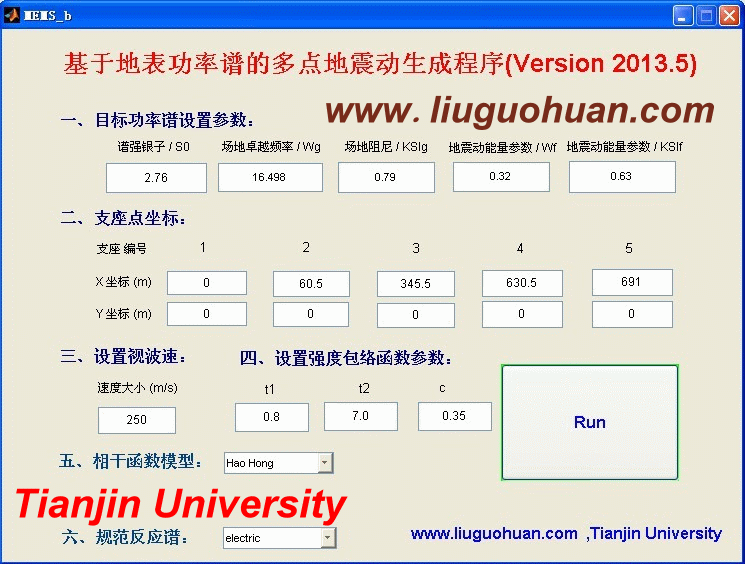Optimal position analysis of secondary systems in yielding structures作者: Guo Wei,Li Hongnan, Liu-Guohuan |
||||||
下载次数:
次 更多论文下载...
PDF格式(左键浏览,右键另存):
Abstract:Based on the code for seismic design of building in China, primary structures usually yield due to severe earthquake loading in practice, so non-linearization of primary structures plays an important role in the dynamic response analysis. In this article, random response of secondary systems mounted on nonlinear primary system under random excitation is studied by using equivalent linearization method, and a 10-storey shearing structures is selected as an example. Using mean square response of secondary system as the objective function the optimal position and corresponding optimal parameters are obtained, and some valuable conclusions are proposed. Keywords:secondary systems, non-linearization, mean square response, equivalent linearization, optimal position. Introduction Primary-secondary systems are usually composed of two parts: primary system and secondary system. The equipment, furniture, architectural elements, and other non-structural components attached to the floors and walls of buildings are called secondary system, and structures which they are mounted on are called primary systems. In the earthquake, although structures maintain serviceable, the failure of secondary systems would also bring severe consequence. Reconnaissance reports and surveys on the seismic performance of non-structural components during past earthquakes report that failure of secondary systems constitutes a major portion of economic losses. In critical facilities, the direct and indirect losses can be more than the cost of replacing the collapsed building or structures. Much research work has been done on the dynamic behaviour of secondary systems connected to a primary structure during the last three decades [1-6]. As a result of an effort from the engineering profession to ensure the survivability of critical installations, such as piping systems and control panels, in nuclear power plants, some simple progress has been generated. However, the simple methods, which have been developed for the design of these components, are approximate methods that just are suitable for particular situations. There are mainly three approaches as follows: floor response spectra, dynamic response analysis of combined systems or cascade systems, and approximate method based on perturbation technique. The composite characteristics of such systems don’t match with usual structures, and traditional methods used for the analysis of classically damped structural systems, are not applicable. Although analysis of such structural systems without considering interaction between the primary and the secondary structural systems, is easy and economical, this analysis gives incorrect responses of the secondary system when the secondary system is not very light as compared to the supporting primary system, and when the frequency of vibration of the secondary system matches with one of the dominant frequencies of the supporting structural system. In such situations, responses of the secondary system, calculated by considering the interaction between the primary-secondary system give more realistic responses of the secondary system. The earthquake is a complex and random process, which can not be described in determinate time history. In the study, random input is adopted as the excitation, and seismic response of primary secondary system is investigated by the theory of random. Based on the code for seismic design of building in China, primary structures usually yield due to severe earthquake loading in practice, so non-linearization of primary structures plays an important role in the dynamic response analysis. Most of the published papers are concerned with elastic primary–secondary structures and only in a relatively small amount of work inelastic structural behavior is included [7-9]. In this article, random response of secondary systems mounted on nonlinear primary system under random excitation is studied by using equivalent linearization method, in which the mean square response is selected as objective function for optimization design of secondary systems. Conclusions This paper has calculated the optimal position of secondary system mounted on nonlinear primary structure by the method of equivalent linearity, and the mean square response is adopted as the optimizing objective function. Key factors influencing the optimal position of secondary system are investigated and some valuable conclusions are gained as follows: 1: The frequency, mass and damping ratio have obvious effect on optimal position of secondary system, while the intensity of earthquake excitation has small effect on optimal position. 2: While the mass of secondary system is small, optimal position usually locates at the bottom of primary system for the low frequency section of secondary system. With the increasing of secondary system’s frequency, optimal position shifts towards the top of primary system for medium frequency section, and then towards the bottom for high frequency section. Moreover, optimal position shifts towards the bottom of primary system with the increasing of secondary system’s mass. 3: With the increasing of damping ratio, optimal position of secondary system shifts from the top to the bottom of primary system References: [1] Igusa T, Der Kiureghian A. (1985). ―Dynamic characterization of two degree-of-freedom equipment–structure systems‖, Journal of Engineering Mechanics, ASCE, 11, 1-19. [2] Igusa T, Der Kiureghian A. (1985). ―Dynamic response of multiply supported secondary systems‖,Journal of Engineering Mechanics, ASCE, 111, 20-41. [3] Muscolino G. (1990). ―Dynamic response of multiply connected primary–secondary systems‖,Earthquake Engineering and Structural Dynamics, 191, 205-216. [4] Chen Y, Soong TT. (1988). ―State-of-the-art review: seismic response of secondary systems‖,Engineering Structure, 10, 218-228. [5] Soong TT. (1995). Seismic behavior of non-structural elements—State-of-the-art report, Proceedings of the 10th European Conference on Earthquake Engineering, Rotterdam: Balkema, 1599-1606. [6] Villaverde R. (1997). ―Seismic design of secondary structures: state-of-the-art‖, Journal of Structural Engineering, ASCE, 123, 1011-1019. [7] Lin J, Mahin SA. (1985). ―Seismic response of light subsystems on inelastic structures‖, Journal of Structural Engineering, ASCE, 111, 400–17. [8] Igusa T. (1990). ―Response characteristics of inelastic 2-DOF primary–secondary systems‖, Journal of Engineering Mechanics, ASCE, 116, 1160-1174. [9] Singh MP, Chang R-S, Suarez LE. (1996). Floor response spectrum amplification due to yielding of supporting structure, Proceedings of the 11th World Conference on Earthquake Engineering, Acapulco, Paper no. 1444. |
||||||
| welcome to www.liuguohuan.net |
| 天津大学 建筑工程学院 ; 天津大学 前沿技术研究院; 国家重点实验室-水利工程仿真与安全 |







